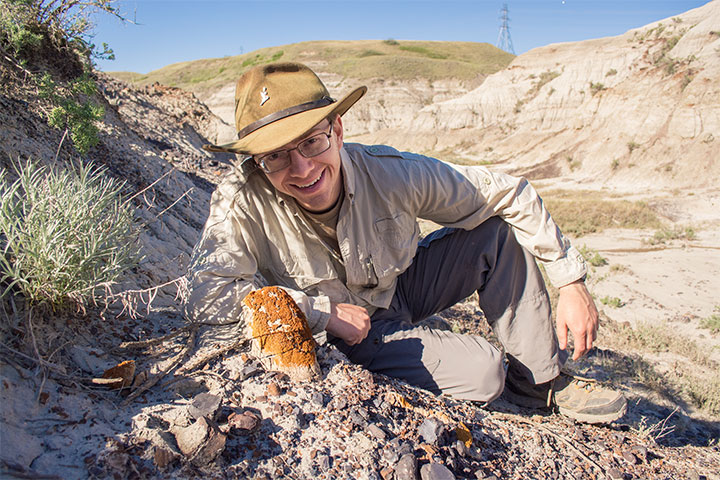Meet Hannah, a strange and anomalous dinosaur that roamed Alberta’s Badlands and appears to be an entirely new species.

The peculiar dinosaur was discovered by Scott Persons from the University of Alberta.
READ MORE: Dinosaurs likely killed by ‘one-two punch’ of volcanic eruption and asteroid collision
“It had been a really, really slow week,” he said of the expedition last summer to the Badlands. “Then I saw this really big orange cone sticking out of the Badlands.”
Once he leaned in to take a closer look, he realized that whatever it was had been encrusted with orange lichen. Then he took a closer look: there, peeking out was a surface of bone, with long grooves. He knew that this had not been caused by erosion.
The grooves were indicative of a horn with canals for blood vessels, similar to those in our modern-day cows and bison.
But the story got even better.
“I thought, ‘That’s really, really cool.’ Then I dug back and saw it was attached to something.” It was clearly attached to a skull, something that was “really, really rare to find.” As he and the team dug deeper, they were thrilled to find that it was an almost complete skeleton.
WATCH: University of Alberta—Hannah’s discovery
So what kind of dinosaur is Hannah? No one knows.
“Loosely speaking, Hannah is a ceratops, a kind of horned dinosaur and relative of the triceratops,” Persons explained. “But the genus is unknown.”
That’s because when they first exposed the skull, they found horns around the frill (the fanned part of a ceratops) that curved outward. Then they found a second set that curved inward. This led them to believe that it was part of the Centrosaurus family. This would be surprising since Centrosaurus are usually found deeper down in the rock (since it’s older).
And then Hannah got a little weirder.
The paleontologists found “enormous spikes” at the rear of the frills, which is associated with Styracosaurus. Those younger dinosaurs would usually be found higher up in the sandstone.
So Hannah isn’t Centrosaurus and she’s not Styracosaurus.
“Hannah is this weird mix and match that we associate with two types of dinosaurs,” said Persons. “Now the question is: Is Hannah its own thing that converged? Is it a missing link?”
The team will now have to further investigate, determining whether or not Hannah is her own type of genus or a link between the two where one evolved into the other.
“It’s very clear Hannah represents something new, just how new is up for debate,” Persons said.
Paleontologists have returned to Hannah’s final resting site where they continue to chisel bone out of the rock. They will take more bones back to the university, and then continue work next summer as they dig further back into the rock to extract the rest of the skeleton.
READ MORE: New dinosaur footprints discovered in Mexico
Though the Badlands are rife with the skeletons and fossils of dinosaurs, Persons said that finding a skeleton such as this is quite rare.
For Hannah, it appears that her skeleton was washed down a river and her enormous skull kept the rest of the skeleton in place as it was buried by sediment and encased in sandstone. Among other finds around Hannah are leaf impressions, fossil wood and even teeth from crocodiles and raptor dinosaurs.
Though Persons has found dinosaurs in the Badlands before, Hannah is by far his most cherished, which might explain why he named her after his dog who often attends digs with him (she wasn’t present at Hannah’s discovery).
“She’s hands down the most spectacular thing I’ve ever found.”
- Budget 2024 failed to spark ‘political reboot’ for Liberals, polling suggests
- Peel police chief met Sri Lankan officer a court says ‘participated’ in torture
- Wrong remains sent to ‘exhausted’ Canadian family after death on Cuba vacation
- Liberals having ‘very good’ budget talks with NDP, says Freeland




Comments